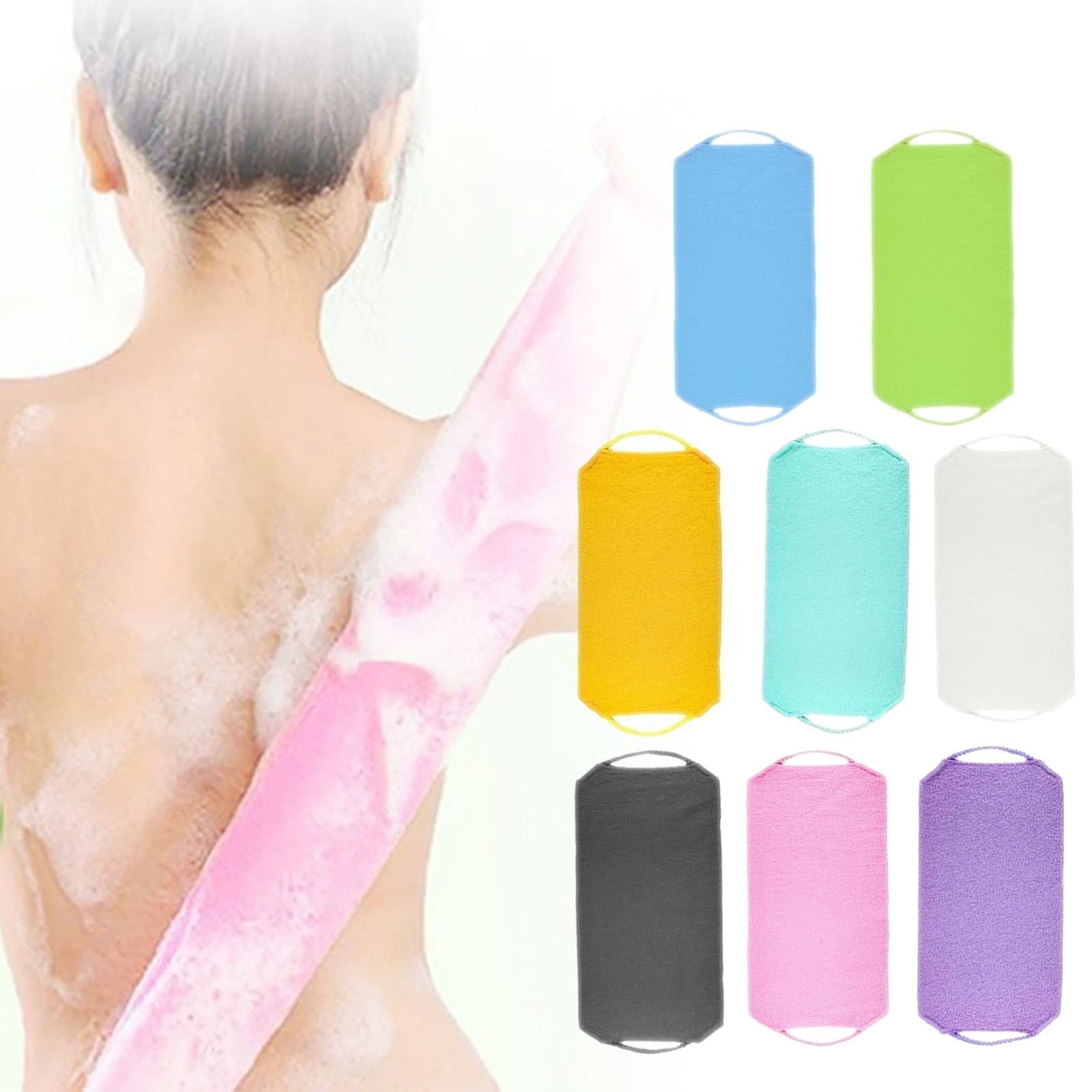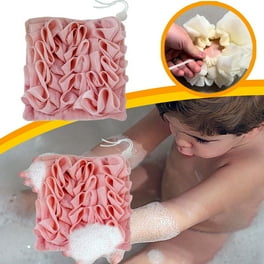Are you torn between using a washcloth, a pouf, or nothing at all when you bathe? Choosing the right tool can make a big difference in how clean and refreshed you feel.
Maybe you want something gentle on your skin but effective enough to remove dirt. Or perhaps you’re looking for a simple routine that fits your busy lifestyle. Keep reading, because understanding the pros and cons of each option will help you find the best way to elevate your bathing experience.
You deserve to feel fresh and confident every time you step out of the shower.
Washcloths Vs Poufs
Choosing between a washcloth and a pouf for your bathing routine can shape your daily experience. Each offers unique benefits and challenges, affecting how you cleanse and care for your skin. Let’s break down their differences so you can decide which suits your needs best.
Material Differences
Washcloths are typically made from cotton, microfiber, or bamboo, offering a soft and absorbent surface. They soak up water and soap well, making them excellent for gentle cleaning.
Poufs, on the other hand, are usually crafted from synthetic mesh materials like nylon or polyester. Their design allows them to create a rich lather quickly, which can save soap and enhance your bathing ritual.
Think about your skin type: do you prefer natural fibers that breathe, or does a foamy experience with synthetic materials appeal to you more?
Texture And Feel
Washcloths provide a smooth, controlled touch. You can easily adjust pressure and target specific areas, which is especially helpful if your skin is sensitive or prone to irritation.
Poufs offer a more exfoliating sensation due to their coarse texture. They help remove dead skin cells effectively but might be too harsh if your skin is delicate.
Ask yourself: do you want a gentle cleanse or a vigorous scrub? Your answer can guide your choice between these textures.
Durability Comparison
Washcloths often last longer because they can be washed and dried thoroughly without losing shape. Their simple weave withstands frequent use and laundering.
Poufs tend to wear out faster, especially with daily use. The mesh can fray or become less effective over time, requiring replacement more often.
Consider how often you want to replace your bathing tool. Are you okay with regular swaps for a softer lather, or do you prefer something that lasts?

Credit: odelebeauty.com
Benefits Of Washcloths
Washcloths offer several benefits for daily bathing routines. They provide a simple, effective way to cleanse the skin deeply. Using a washcloth can improve skin texture and cleanliness without harsh tools.
Gentle Exfoliation
Washcloths help remove dead skin cells gently. This exfoliation makes skin feel smoother and look fresher. It prevents clogged pores and reduces rough patches. The soft fabric is kind to sensitive skin, avoiding irritation.
Ease Of Use
Washcloths are easy to handle and control during bathing. They fit well in the hand, allowing precise cleaning. Quick to rinse and dry, they stay fresh for regular use. No complex setup or special care needed.
Hygiene Factors
Using a clean washcloth promotes better hygiene. They can be washed frequently to prevent bacteria buildup. Separate cloths can be used for face and body to avoid cross-contamination. Proper drying reduces mold and mildew growth.
Advantages Of Poufs
Choosing the right bathing accessory can enhance your shower experience. Poufs, often overlooked, offer several advantages. These soft, puffy tools are not just for luxury; they serve practical purposes too.
Lathering Ability
Poufs create a rich, luxurious lather with minimal soap. This makes them cost-effective. The mesh design helps spread soap evenly across your skin. This ensures a thorough and satisfying clean.
Skin Stimulation
Poufs gently exfoliate and stimulate the skin. They remove dead skin cells, revealing fresh, glowing skin. This can improve circulation and leave you feeling refreshed.
Quick Drying
The airy structure of poufs allows them to dry quickly. This reduces the chance of bacteria and mold. A dry pouf stays fresh and hygienic for longer use.

Credit: www.walmart.com
When To Choose Nothing
Choosing nothing over a washcloth or pouf can be the best choice in certain situations. Some people find that skipping these tools helps their skin feel healthier and cleaner. Others prefer a simpler approach that fits their lifestyle. The decision depends on your skin type, habits, and values.
Sensitive Skin Concerns
Using no cloth or pouf reduces irritation. Rough textures can cause redness or itching. Water and gentle hands often clean skin well enough. Avoiding extra scrubbing helps prevent dryness and damage. People with eczema or rosacea benefit from this simple method.
Minimalist Bathing
Bathing without tools keeps routines simple. No need to buy or replace items often. It saves time and effort in cleaning bath accessories. This approach suits those who prefer less clutter. It focuses on the essentials: soap, water, and gentle care.
Environmental Impact
Skipping washcloths and poufs lowers waste. No need to wash or discard them regularly. It reduces water and detergent use during laundry. Choosing nothing means fewer materials produced and thrown away. This method supports a more eco-friendly lifestyle.
Cleaning And Maintenance Tips
Keeping your washcloths and poufs clean is key to a refreshing and hygienic bathing routine. Neglecting this step can lead to bacteria build-up and unpleasant odors that undo all the effort you put into staying clean. Let’s dive into simple, practical tips to maintain these bath essentials so they last longer and keep you feeling fresh.
Washing Washcloths
Washcloths trap dirt, oil, and dead skin, so they need regular cleaning. Use hot water and a mild detergent to kill germs effectively. Avoid fabric softeners as they can leave a residue that reduces absorbency.
Try to wash washcloths separately or with towels to avoid lint transfer. If you spot stubborn stains, soak them in a mixture of water and baking soda before washing. How often do you change your washcloth? Aim for at least twice a week to keep bacteria at bay.
Caring For Poufs
Poufs can hold soap scum and moisture, which makes them a breeding ground for bacteria. Rinse your pouf thoroughly after each use to remove soap and dead skin. Squeeze out excess water gently instead of twisting to avoid damaging the fibers.
Air dry your pouf in a well-ventilated area, ideally hanging it up to prevent mold growth. Replace your pouf every 3 to 4 weeks, especially if it starts to smell or feels slimy. Have you noticed your pouf losing its softness? That’s a sign it’s time for a new one.
Preventing Bacteria Build-up
Bacteria love damp environments, so keeping your bath accessories dry is crucial. Don’t leave wet washcloths or poufs bunched up in the shower or hamper. Instead, spread them out or hang them in a sunny spot to dry quickly.
Consider using a disinfectant spray once a week on your pouf and washcloths. You can also soak them in diluted vinegar occasionally to kill germs naturally. Are you aware that regular cleaning not only protects your skin but also extends the life of your bath tools?
Personal Preferences And Skin Types
Choosing between a washcloth, pouf, or nothing depends on your skin type and personal preference. Different skin types need different care tools. What feels good for one person might irritate another. Understanding your skin helps you pick the best bathing option.
Oily Vs Dry Skin
Oily skin can benefit from gentle exfoliation. A pouf helps remove excess oil and dead skin cells. Use it lightly to avoid overstimulation. Dry skin needs soft and mild cleansing. A washcloth with a gentle touch prevents irritation. Avoid rough scrubbing that can strip natural oils.
Acne-prone Skin
Acne-prone skin requires careful cleansing. A soft washcloth works better than a rough pouf. It cleans without spreading bacteria or causing breaks. Avoid harsh scrubbing as it may worsen acne. Using just hands can be safest for sensitive areas.
Aging Skin Considerations
Aging skin becomes thinner and more delicate. A washcloth with soft fibers is ideal for gentle cleansing. Avoid rough poufs that can cause micro-tears. Moisturizing after bathing helps keep skin smooth and hydrated. Choose tools that support skin health and comfort.
Cost And Accessibility
Cost and accessibility are key factors in choosing between a washcloth, pouf, or nothing for bathing. These options vary widely in price and availability. Understanding their costs helps make a smart choice. Accessibility ensures you can easily get what you need without hassle.
Price Comparison
Washcloths usually cost less than poufs. A basic washcloth can be under $5. Poufs often range from $5 to $15. Some designer poufs may cost even more. Bathing with nothing is free but may not clean as well.
Consider these points:
- Washcloths: Low cost, simple to replace.
- Poufs: Moderate price, offer exfoliation.
- Nothing: No cost, less effective for cleansing.
Availability Options
Washcloths are easy to find. Most stores and online shops sell them. Poufs are also common but may not be in all stores. Specialty stores and online shops usually have a better selection. Bathing with nothing requires no purchase, always available.
Accessibility highlights:
- Washcloths: Widely available everywhere.
- Poufs: Available but less common in some areas.
- Nothing: Accessible anytime, no shopping needed.
Longevity And Replacement
Washcloths last longer with proper care. They can be washed and reused many times. Poufs wear out faster and need regular replacement. They may tear or collect bacteria over time. Using nothing has no replacement cost but may not clean well.
Key points on durability:
- Washcloths: Durable, easy to clean.
- Poufs: Shorter lifespan, replace often.
- Nothing: No maintenance or replacement.

Credit: www.amazon.ca
Eco-friendly Alternatives
Choosing eco-friendly alternatives for bathing helps reduce waste and pollution. These options use natural or reusable materials that break down easily or last longer. They support a cleaner planet and often feel gentle on the skin. Explore simple choices that fit your routine and care for the environment.
Reusable Materials
Reusable bath tools cut down on single-use waste. Cotton washcloths and bamboo fiber poufs are soft and durable. They wash well and dry quickly, preventing mold. These materials save money over time and reduce landfill waste.
Biodegradable Options
Biodegradable bath products break down naturally after use. Sponges made from natural sea materials or loofah plants work well. They do not release harmful chemicals into water systems. These options leave no lasting pollution behind.
Diy Bath Tools
Making your own bath tools is fun and eco-friendly. Use old clothes or towels to create washcloths or poufs. Knitting or crocheting with cotton yarn is another choice. DIY tools reduce waste and add a personal touch to bathing.
Frequently Asked Questions
What Is A Washcloth Pouf?
A washcloth pouf is a textured bath accessory made from a washcloth. It helps create rich lather and exfoliates skin gently during bathing.
Are Washcloth Poufs Better Than Regular Washcloths?
Yes, washcloth poufs provide better exfoliation and lather. They save soap and offer a spa-like bathing experience compared to plain washcloths.
Can A Washcloth Pouf Replace A Bath Sponge?
A washcloth pouf can replace a bath sponge for most uses. It is gentler, easier to clean, and dries faster than many sponges.
How Often Should I Replace A Washcloth Pouf?
Replace a washcloth pouf every 3 to 4 weeks. Frequent replacement prevents bacteria buildup and maintains skin hygiene during bathing.
Conclusion
Choosing between a washcloth, pouf, or nothing depends on your needs. Each option offers a different feel and cleaning style. A washcloth gives control and gentle scrubbing. A pouf creates rich lather and exfoliates skin. Bathing with nothing is simple and quick.
Think about your skin type and comfort. Try each to see what works best. Clean skin feels good and boosts confidence. Enjoy your bath time, whichever way you choose.





